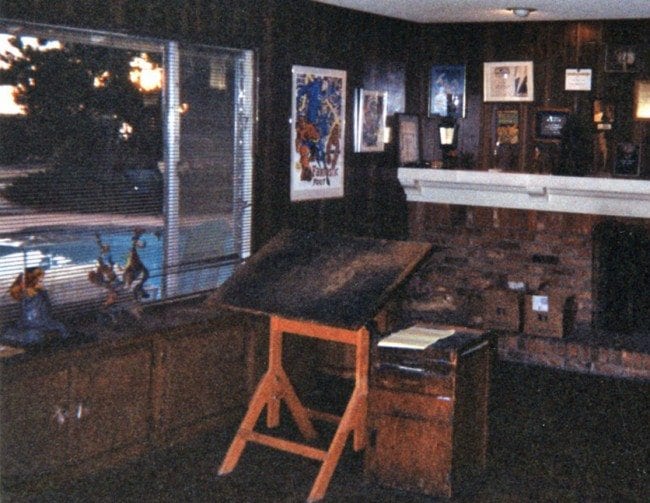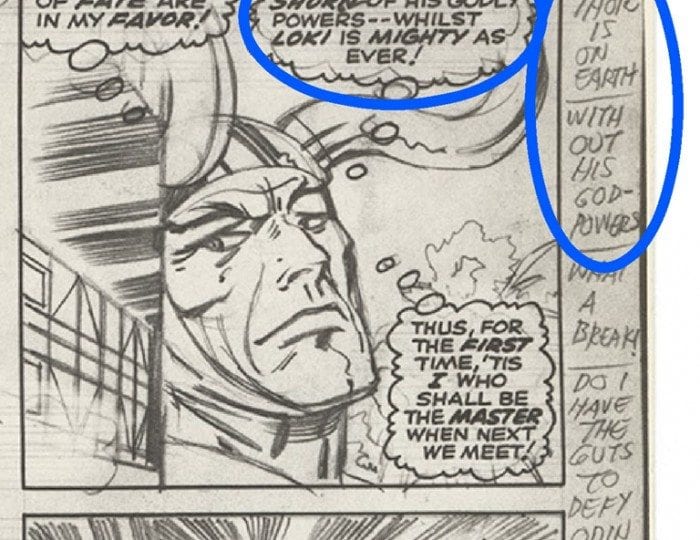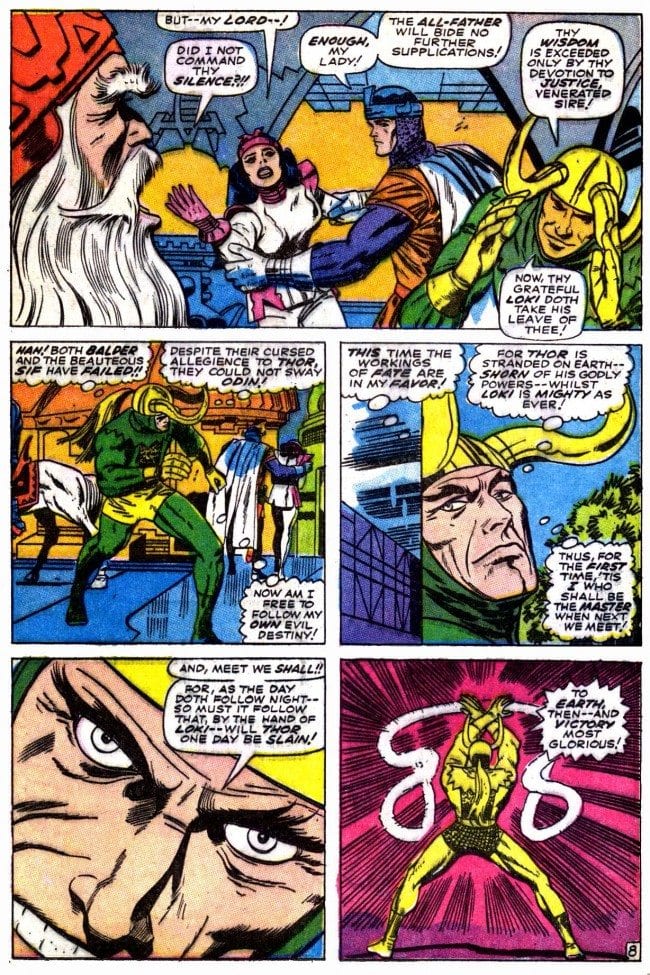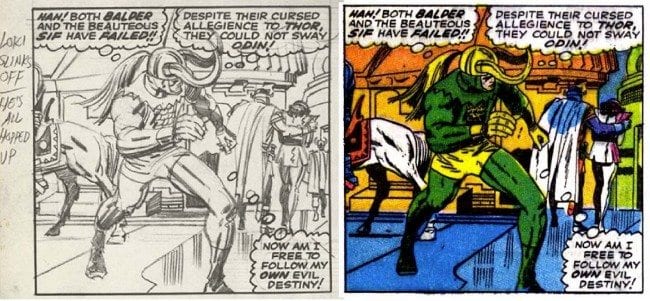If Jack Kirby was still cranking out stories and art at this unassuming, spartan drawing board he would be 96-years-old today. As many of you know, Jack died in 1994 which was way before his time. If he’d lived another 20 years one can only imagine the masterpieces he would have created -- maybe he could have dabbled a bit in other mediums like sculpture or film. This is a rare example of Jack working with paint in the late 1960s.
 Here’s a photograph of the finished piece from comicartfans.com. You can see the colors have faded a bit over the years but it’s still a spectacular piece of Kirby bio-tech, notice the robotic face on the right side of the image.
Here’s a photograph of the finished piece from comicartfans.com. You can see the colors have faded a bit over the years but it’s still a spectacular piece of Kirby bio-tech, notice the robotic face on the right side of the image.
 About 700 American World War II veterans are passing away every day -- that’s every single day, not every month. In the next 24-hours about 700 American men and women who fought to defend our liberty in the 1940s will be laid to rest. Their average age is 94, so by 2020 all but a few of our WW II veterans will be gone. The loss of these brave, honorable, hard-working Americans is going to be a devastating loss for all of us. If you’ve known anyone from that generation, I can almost guarantee you will agree with me when I say the WW II generation were the most kind-hearted, hard-working, intelligent, humble group of people imaginable. Here’s a photo of Jack and his wife Rosalind in Manhattan (1944), from their granddaughter Jillian Kirby’s website Kirby4heroes. All the Kirby family photos in the rest of this article are from Jillian’s website.
About 700 American World War II veterans are passing away every day -- that’s every single day, not every month. In the next 24-hours about 700 American men and women who fought to defend our liberty in the 1940s will be laid to rest. Their average age is 94, so by 2020 all but a few of our WW II veterans will be gone. The loss of these brave, honorable, hard-working Americans is going to be a devastating loss for all of us. If you’ve known anyone from that generation, I can almost guarantee you will agree with me when I say the WW II generation were the most kind-hearted, hard-working, intelligent, humble group of people imaginable. Here’s a photo of Jack and his wife Rosalind in Manhattan (1944), from their granddaughter Jillian Kirby’s website Kirby4heroes. All the Kirby family photos in the rest of this article are from Jillian’s website.
 Today on Jack’s birthday, I encourage you to not only take a moment to reflect on the life and work of Jack Kirby, but also please remember all the American soldiers who fought for our freedom over the years, especially our few surviving WW II veterans, and their families because they all played a role in defeating fascism. Here’s another photo of Jack and his family, an archetypal American middle class family, June 1954.
Today on Jack’s birthday, I encourage you to not only take a moment to reflect on the life and work of Jack Kirby, but also please remember all the American soldiers who fought for our freedom over the years, especially our few surviving WW II veterans, and their families because they all played a role in defeating fascism. Here’s another photo of Jack and his family, an archetypal American middle class family, June 1954.
For the last three years I’ve been doing a daily weblog about Jack Kirby called Kirby Dynamics which was my version of the Daily Show meets Saturday Night Live focused on the life and work of Jack Kirby -- I covered news stories and analyzed the history while also trying to have fun along the way. For a bunch of reasons I decided to pull the plug on that project, but as we move towards Jack’s 100th birthday I still wanted to keep my toe in the water, so my thanks to the editors of The Comics Journal for giving me a chance to do a monthly column I’m calling “Jack Kirby: Behind The Lines.” It’s a privilege to have the opportunity to honor Jack’s career here at The Comics Journal. As long as comics are being written and drawn I’m sure TCJ will be at the vanguard of comics scholarship and comics journalism. I’ll try not to ruin their website.
The reason I picked the over-used cliché “behind the lines” for this series is probably going to be pretty obvious. Each month I’m going to take a look at Jack Kirby original pencils and examples of Kirby original art -- images that reveal information not in the final newsprint publications. I may also take a look at some scans of Jack’s pencils from the 70s and compare those to the printed books. Mainly I want to focus on Jack’s famous margin notes from his 1960s work so we can get a glimpse into the Jack Kirby/Stan Lee collaboration.
I’m also calling the column “behind the lines” because Jack literally fought behind enemy lines during the second world war. Jack served in the 3rd army, 5th division under General Geroge S. Patton. Here is a photo of Jack at basic training in Camp Stewart, Georgia, July, 1944.
 Kirby was a combat infantryman, and he served as an advance scout -- an incredibly dangerous assignment since each step could result in instant death from anything from an enemy landmine to a sniper's bullet. Here is a Kirby family photograph of Jack in battle gear at Camp Picket, Virginia shortly before shipping out to Europe, June, 1944.
Kirby was a combat infantryman, and he served as an advance scout -- an incredibly dangerous assignment since each step could result in instant death from anything from an enemy landmine to a sniper's bullet. Here is a Kirby family photograph of Jack in battle gear at Camp Picket, Virginia shortly before shipping out to Europe, June, 1944.
 You have to think if the Nazis had captured Jack and found out he was the illustrator of this iconic cover, Jack's stay in an enemy torture chamber would have been most unpleasant. Captain America # 1 (Mar 1941).
You have to think if the Nazis had captured Jack and found out he was the illustrator of this iconic cover, Jack's stay in an enemy torture chamber would have been most unpleasant. Captain America # 1 (Mar 1941).
 Jack wasn’t just a comic book cartoonist -- he was a warrior/artist, a genuine hero/creator. Not too many of those around anymore. Many of you may have read Joesph Campbell’s famous book A Hero with a Thousand Faces (first published in 1949) where Campbell explored the reoccurring myths that appear all over the globe throughout recorded history.
Jack wasn’t just a comic book cartoonist -- he was a warrior/artist, a genuine hero/creator. Not too many of those around anymore. Many of you may have read Joesph Campbell’s famous book A Hero with a Thousand Faces (first published in 1949) where Campbell explored the reoccurring myths that appear all over the globe throughout recorded history.
I don’t think it would be a stretch to say Jack was a mythmaker in that long tradition. And because of his prolific output I’d also suggest Jack Kirby was “The Hero who Created a Thousand Heroes.”
Here's a quote from Jillian Kirby's kirby4heroes website next to that photo:
Jillian Kirby: Taken in March 1945, "Home from the Wars" was the description written on the back of this picture by my grandma Roz. For you WWII history buffs, I am proud of the medals and badges pictured on his uniform: Combat Infantry Badge, Rhineland G0 40 WD45 Campaign Ribbon, European African Middle Eastern Theatre Ribbon with One Bronze Battle Star. I see his patriotism and combat experiences reflected in many of his comics such as Foxhole and Captain America.
Before I begin this month’s piece, some very quick background: I’m going to assume most of you have a general understanding of comics history (if not an encyclopedic one that dwarfs mine), so I won’t rehash the whole Kirby/Lee authorship debate. If you want an introductory course in Jack’s margin notes check out Mike Gartland’s series he wrote for John Morrow’s Jack Kirby Collector called “A Failure to Communicate” -- Mike was a pioneer in the exploration and analysis of Jack’s margin notes and I encourage you to support TJKC. I did a couple series for HiLobrow where I broke down some of the basics of the Kirby/Lee authorship debate: one was called “Btoom! Kirby vs. Lee,” the other “Galactus Lives.” Here is a link to all the installments: HiLobrow Kirby Close-Up series. I’ve talked about the margin notes at length at Kirby Dynamics: here is a post Fantastic Four # 14, page 12 I’d like you to check out (unfortunately the Kirby Museum changed the settings on their website recently so the format is messed up). This was an early article where I put forth my theory that from 1959 – 1963, I suspect Jack was doing the bulk of the storytelling using visuals (Stan Lee added text to Jack’s stories), then when Jack would turn in the finished penciled stories Kirby would verbally go through the story with Lee in his office briefly explaining to Stan what was happening on each page; Lee sometimes would make tiny notes to himself based on Jack’s direction. I think the conversational, friendly, even humorous tone in Jack’s monologue was probably very similar to what you see in Jack’s margin notes which started appearing in late-1963 and continued all the way through 1970 when Jack left Marvel to work at DC. After that, Jack simply wrote text in the word balloons himself as you can see in this example: a low-resolution pencil scan downloaded from the internet, New Gods # 8, pg. 20 (Apr 1972).
In the future we’ll probably examine several pages since this is a monthly column, but for today let’s look at a single piece of art and see what we can learn from it. This scan was recently posted by Tom Kraft at his site whatifkirby.com. Thanks to Tom for giving me permission to use the scan, and thanks to Rand Hoppe at the Kirby Museum for working to scan all of Jack’s pencil photocopies. This is a photocopy of the pencils for Thor # 147, pg. 8 (Dec 1967). To start off, I digitally erased Lee’s captions, not to eradicate Lee from the record but to show you what the page looked like when Lee opened the package featuring Jack’s entire Thor # 147 story. In the past Lee has said the process of adding text to Jack’s stories was like doing a crossword puzzle. I encourage you to read Jack’s notes, look at the art and think about how you might add text to this piece.
Here’s the complete scan of the page:
 The quality of the source photocopy is exceptionally good. It’s rare to have all the margin notes intact, usually about 3/4 of them were cut off in production so only fragments remain. A lot of the scans of Jack’s pencils are poor, probably because the ink cartridge in the photocopier was running low, and I don’t think Jack’s home photocopier was that good to begin with. But this is very high quality -- in all likelihood it was made at the Marvel offices for some unknown reason since they rarely did that.
The quality of the source photocopy is exceptionally good. It’s rare to have all the margin notes intact, usually about 3/4 of them were cut off in production so only fragments remain. A lot of the scans of Jack’s pencils are poor, probably because the ink cartridge in the photocopier was running low, and I don’t think Jack’s home photocopier was that good to begin with. But this is very high quality -- in all likelihood it was made at the Marvel offices for some unknown reason since they rarely did that.
You can see Jack’s pencils are strong, confident, and detailed. This work is almost publication-ready today with digital enhancement. Jack rarely used an eraser. A lot of artists from that period would not pencil backgrounds and leave that up to the inker. Not so with Kirby, and remember Jack was knocking out at least three entire 20-page books a month in the 1960s, plus covers and annuals so if he wanted to cut corners he could have left out extemporaneous detail. But I think Jack was a perfectionist, he realized the backgrounds played an integral role in the overall composition of each panel so he always made sure to create an effective marriage of foreground/background. Jack illustrated at least 10,000 pages in the 1960s so fans always talk about how “fast” Jack was, and he certainly was, but he still spent about 2 – 3 hours on each page, so illustrating 3 pages of story would take a full 8 – 9 hour shift at least. So, yeah, Jack was faster than an artist who spends a whole day laboring over a single page, but the guy was still working at a breakneck pace, sometimes 12-hours a day, 7-days a week if he was doing additional work.
Okay, let’s dive in. We’ll look at each panel individually.
Thor # 147, pg. 8, panel 1
 Jack’s margin notes tend to tell Lee what is happening, where the story is going, what the characters are doing, and what the characters psychological motivations are. These notes set the stage for the whole page. Jack’s directions at the top of this panel for Stan Lee say: “Odin is now testing the strength of his commands -- that’s why Loki is back -- that’s why Sif and Balder are admonished! Are their personal desires stronger than Odin’s orders -- like Thor?”
Jack’s margin notes tend to tell Lee what is happening, where the story is going, what the characters are doing, and what the characters psychological motivations are. These notes set the stage for the whole page. Jack’s directions at the top of this panel for Stan Lee say: “Odin is now testing the strength of his commands -- that’s why Loki is back -- that’s why Sif and Balder are admonished! Are their personal desires stronger than Odin’s orders -- like Thor?”
One thing I’m going to do in this series is highlight examples where I think Stan Lee follows Jack’s directions in his captions. Here’s the first example.
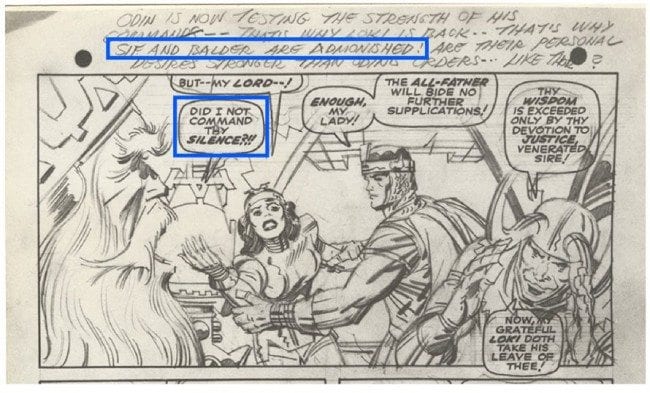 Pretty self-explanatory: Lee has Odin verbally admonish Sif. Visually Jack makes it clear there is conflict between the characters; Balder pulls Sif away from the “All-Father” -- the visuals obviously influence Lee’s text. You see Loki is bowing before Odin, raising his hands in a sign of supplication, ironic because Lee has Balder use that term in his caption. I doubt Jack would have wanted the final word balloon that is falling out of the bottom of the panel in the image, it ruins the flow of a solid left-right composition, and you can see there was barely enough room for the letterer to add that caption without writing over Loki’s face or hands. Loki is bowing out of the image, exiting stage right, the word balloon reminds me of Public Enemy Flavor Fav’s clock necklace. It’s superfluous.
Pretty self-explanatory: Lee has Odin verbally admonish Sif. Visually Jack makes it clear there is conflict between the characters; Balder pulls Sif away from the “All-Father” -- the visuals obviously influence Lee’s text. You see Loki is bowing before Odin, raising his hands in a sign of supplication, ironic because Lee has Balder use that term in his caption. I doubt Jack would have wanted the final word balloon that is falling out of the bottom of the panel in the image, it ruins the flow of a solid left-right composition, and you can see there was barely enough room for the letterer to add that caption without writing over Loki’s face or hands. Loki is bowing out of the image, exiting stage right, the word balloon reminds me of Public Enemy Flavor Fav’s clock necklace. It’s superfluous.
I’m going to try not to be overly-critical of Lee’s dialogue, but I don’t think that caption is necessary; it’s obvious in the next panel that Loki is leaving, so there’s really no need for Loki to telegraph it with a caption. And I don’t know about the rest of you, but sometimes I don’t even understand what Lee Thor-dialogue means. For example, Lee has Loki say: “Now my grateful Loki doth take his leave of thee.” Why is Loki calling himself “my grateful Loki?” Shouldn’t it be “thou grateful Loki,” or “thy grateful Loki?” Isn’t Lee’s caption a kind of double-first-person remark? “I, me.” Lee Thor dialogue is just bizarre sometimes, but I guess when you make up your own language you have to fabricate the grammar on the fly; and people do love made-up languages like Klingon and all the new languages in shows like Game of Thrones, so maybe Lee was ahead of his time? Now my grateful writer of this column doth take leave of this panel.
Thor # 147, pg. 8, panel 2
Jack’s directions for Stan Lee say: “Loki slinks off / He’s all hopped up.” Notice Jack separates ideas by dashes ( -- ) at the top and bottom of the page, then on the sides where there is less room, he tends to use a single line ( __ ). This is a great example of Jack’s margin notes just filling space, what is happening in the image is obvious and doesn’t require explanation. Loki is sneaking off to, no doubt, spread mischief like the archetypal trickster rabbit of ancient North American mythology. Balder and Sif look defeated, their shoulders slouched, they walk away conquered. Lee’s dialogue reflects that when Loki says “Balder and the beauteous Sif have failed.”
One thing I find interesting about Jack's margin notes: they are very conversational and friendly, and funny at times even when the subject matter is serious. Jack is having fun, doing something he loves; it comes through in the art and the margin notes. I strongly suspect this is how Jack verbally explained his stories to Lee when they would meet F2F before Jack started using the margin notes in late 1963. In his own voice Jack would explain essential elements of his story to his editor, panel-by-panel. I think the notes on this page capture a playfulness and humor in Jack's character you can see in some of these family photos.




Thor # 147, pg. 8, panel 3
 Jack’s directions for Stan Lee say: “So Thor is on Earth / without his god-powers / What a break! / Do I have the guts to defy Odin once again?”
Jack’s directions for Stan Lee say: “So Thor is on Earth / without his god-powers / What a break! / Do I have the guts to defy Odin once again?”
I circled Jack's margin notes and Lee's captions in blue where the Kirby notes/Lee captions agree -- as you can see, inside the circles Lee's text mirrors Jack's directions. But Lee decided to move in a bit of a different direction in relation to Jack's other notes -- notice instead of having Loki ponder whether he should defy Odin (as Jack suggests), Lee decided for Loki to take a more active approach towards his brother.
A subtle change, but one worth pondering: in Jack's version, Loki is cowardly, wondering if he has the "guts" (as Jack puts it) to challenge his powerful Father. Notice Loki is visually hiding behind a wall -- lurking, scheming. On the other hand, Lee's text focuses purely on Loki's desire to defeat the god of thunder. I think you could argue Jack's approach adds more complexity to Loki's character and fits the visual, plus in some respects Lee's caption is redundant because Jack has Loki turn his sights to defeating Thor in the next panel. This is just one example of the tug of war that took place between Jack and Lee on the page itself where both men were trying to put forth their own vision. There are hundreds if not thousands of examples of this in the margin notes that survive.
Thor # 147, pg. 8, panel 4
Jack’s directions for Stan Lee say: “Thor is at my mercy -- I may never get another chance to nail him like this.”
Jack’s notes suggest Loki knows he may never get another opportunity like this to destroy Thor, but Lee doesn’t use that idea, instead Lee has Loki doing typical bad guy ranting. Once again, I think Jack’s directions add another lost layer of meaning to the page that helps establish the character -- Loki is a conspirator, he knows he has to seize this rare chance to eliminate his brother immediately, time is of the essence -- in Lee’s text Loki is just raving maniacally.
Thor # 147, pg. 8, panel 5
Jack’s directions for Stan Lee say: “Loki can’t resist break! -- he used trans-dimensional gestures he learned from wicked norn enchantress.”
This is one of the reasons I wish we had copies of all Jack’s margin notes. Although Lee didn’t use Jack’s concepts in the captions, examining a source document like this adds an additional layer to Jack’s original story -- it’s a lot like a footnote, or a behind the scenes narration a director adds to a film. The reason behind Loki’s gestures are lost when the page was captioned then printed, but looking at the pencils we can see there is more going on than meets the eye in Jack’s imagination. There are many layers to the story in Jack’s mind. But I think Lee’s decision here to add a simple, small caption is effective in terms of keeping the story flowing. There was really no need for a lengthy piece of dialogue or a long caption. Kirby Purists will crucify me for this, but these types of moments where Lee steps out of the way and lets Jack’s imagery carry the story are very effective.
But make no mistake, Jack Kirby was what I call “The Principal Author” of The Mighty Thor # 147.

As the Principal Author Jack wrote the story with visuals and directions for Stan Lee in the margins.
Stan Lee was the “Secondary Author,” who took Jack’s story/art then added text in the word balloons and caption boxes based on Jack’s art and Jack’s margin notes. In my opinion, an accurate credit on the front page of this story should have read:
Writer/Artist: Jack Kirby
Writer/Editor: Stan Lee
That’s a fair description of the chronology as well, the story started on Jack’s drawing board, it ended with Lee in the New York offices, and if the True Believers would have found such a designation of credit confusing, Lee easily could have explained this division of labor in his letters columns or his bullpen bulletins which appeared in every Marvel magazine every month.
Here is a scan of the published page.
The colors and printing make a semi-mess of the artwork. Those seemingly haphazard splotches of sky-blue on Balder’s cape and glove, the area around Loki’s neck should be yellow, no color in the eyes in panel 4 -- all make for classic, muddled 60s four-color publishing. Vince Colletta does his job here and makes Jack’s pencils suitable for publication. For the most part he delineates the images in Jack’s artwork, but you can see Colletta tends to add scratchy lines to areas where Jack had drawn solid shading. There is one relatively insignificant omission on the page. Note the character in the bottom right corner of the panel below disappears in the published version, something pretty common in a lot of Colletta-inked Thor. Almost like a character stepping into the 60s Star Trek transporter.
Colletta’s decision to delete that Asgardian pedestrian doesn’t really hurt the page, you could argue it actually helps highlight Sif and Balder, but Jack put details like that in there for a reason, mainly to show that Thor’s world is a bustling universe full of diverse costumed characters and imaginative flowing technology.
That’s all for that page, but we’ll look at several more Thor pages in the future. I’m not sure how this column will evolve -- right now I plan to focus on reporting on what we find on the artwork and analyzing that as opposed to composing satire and making wisecracks as I did on my old daily Kirby Dynamics weblog, but as I was writing this article a decision came down in the latest round of the Marvel vs. Kirby lawsuit so I did want to make one comment since everybody else on the internet is weighing in. I’m going to shock you all and say I think this recent Marvel/Disney vs. Kirby court decision is a good thing. Yeah. That’s right, I disagree with just about every internet comment I’ve read on the judge’s ruling: I think it’s fantastic that Marvel stomped on Kirby like he was a little tiny, eensy-weensie ant and grinded him into the concrete like he was nothing. Sure, I’d love to see Jack’s family get a tiny percentage of the billions of dollars Marvel is raking in (and Marvel might settle with them one day), but to me the decision just adds to Jack’s status as a true American folk hero.
You had this kid who survived the depression, found a sci-fi pulp in the gutter one day and started drawing, despite the horrible economy he was able to find work as an artist, he was there at the dawn of the animation industry and the comics industry, he graduated from comic strips to comic books, helped create Captain America, served his country in WW II where he almost lost both feet to frostbite, he returned home to raise a family, helped invent the romance genre in comics, totally reinvented the superhero genre, created the first comics epic with the Fourth World, produced great work in animation, fought for artists rights, helped invent the comics direct market, and after he passed away his family carried on the fight trying to get him well-deserved credit and compensation. Sounds like that would make a pretty good folk tale to me -- you’d have to think such a character deserves to stand beside the likes of Yankee Doodle, Johnny Appleseed and Paul Bunyan. True working class American heroes.
Unfortunately you’d be hard pressed to find 1 out of 100 kids in many American neighborhoods who could even name all 4 Beatles right now, so it’s probable that people won’t have any conception of comics or comics history in the future (or any history for that matter) which means Jack Kirby may never achieve true folk hero status. What’s far more likely is that Jack’s 1960s editor Smilin’ Stan (The Man) Lee will end up being the next great American folk hero – or a Legend like King Arthur or Robin Hood. If the corporate machine keeps promoting him, Lee will stand amongst the titans of human creativity, his name synonymous with the likes of Homer or William Shakespeare. In fact the former already happened -- here's a new French book on the art of Stan Lee by an author named Jean-Marc Lainé. The book is called Homère du XXe siècle. The English translation of the title is "Stan Lee: A 20th-Century Homer." Thanks to Frédéric Cwiécinski from the Kirby tribute site Kirbyholic for passing along that link.
 I’ve had people tell me over the years that Stan Lee is not just the “Homer of Comics,” but Lee is also “The Shakespeare of Comics. “ Here’s a link to one author making that claim: Why Stan Lee is the Shakespeare of the 20th Century. Since people love to quote Shakespeare I thought it might be fun to have the old bard himself, the real Shakespeare, quote the other Shakespeare – “The Shakespeare of Comics” a few times. Here are a few pieces of satire I ran at Kirby Dynamics recently.
I’ve had people tell me over the years that Stan Lee is not just the “Homer of Comics,” but Lee is also “The Shakespeare of Comics. “ Here’s a link to one author making that claim: Why Stan Lee is the Shakespeare of the 20th Century. Since people love to quote Shakespeare I thought it might be fun to have the old bard himself, the real Shakespeare, quote the other Shakespeare – “The Shakespeare of Comics” a few times. Here are a few pieces of satire I ran at Kirby Dynamics recently.
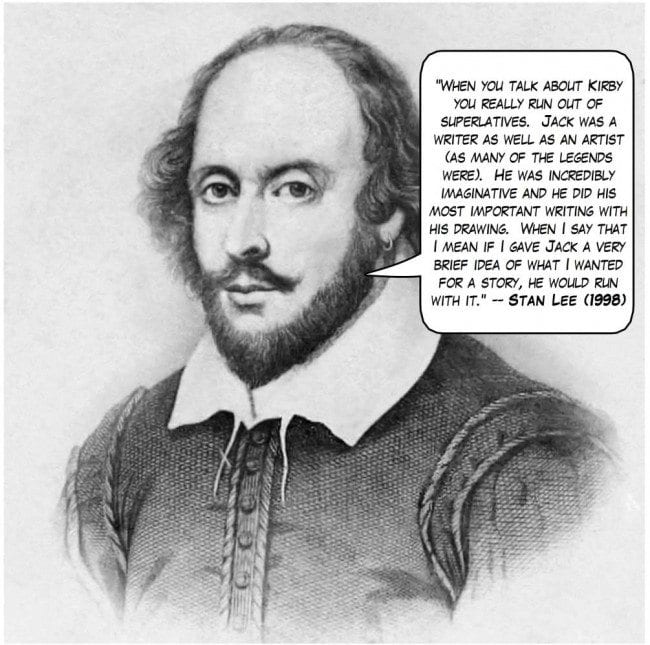



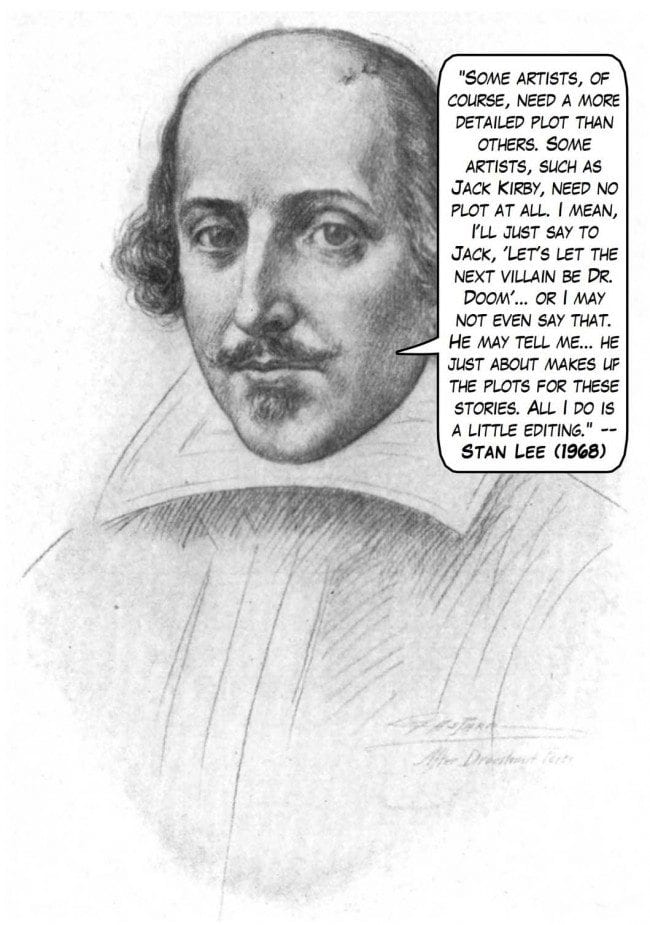
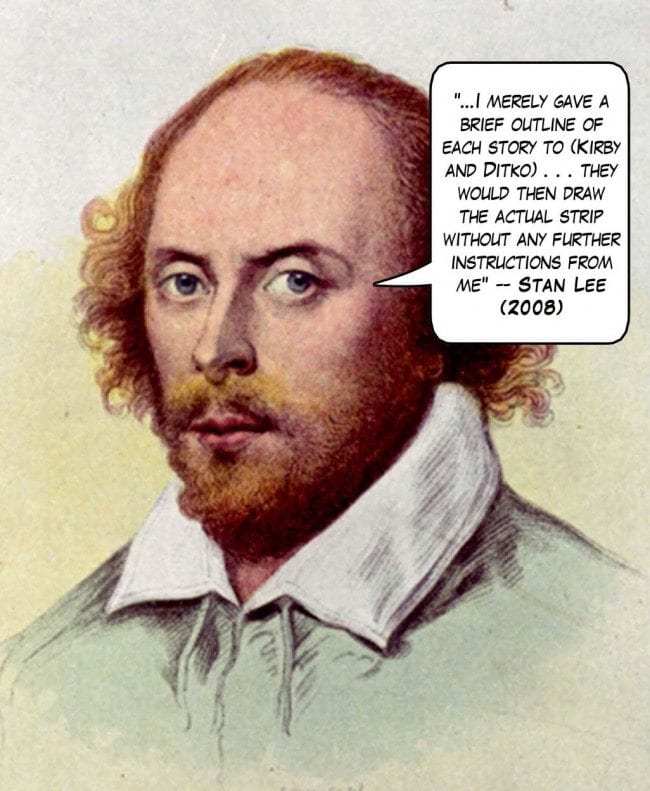 That’s it for today’s column. And since this is “Jack Kirby: Behind the Lines” I want to give Kirby the last word and end with a piece of Jack’s art that reflects his service to his country. Here’s a simple, sublime, intense, foreboding yet beautiful piece of comics art: the cover for Foxhole #4 (1955). Art by Jack Kirby.
That’s it for today’s column. And since this is “Jack Kirby: Behind the Lines” I want to give Kirby the last word and end with a piece of Jack’s art that reflects his service to his country. Here’s a simple, sublime, intense, foreboding yet beautiful piece of comics art: the cover for Foxhole #4 (1955). Art by Jack Kirby.


